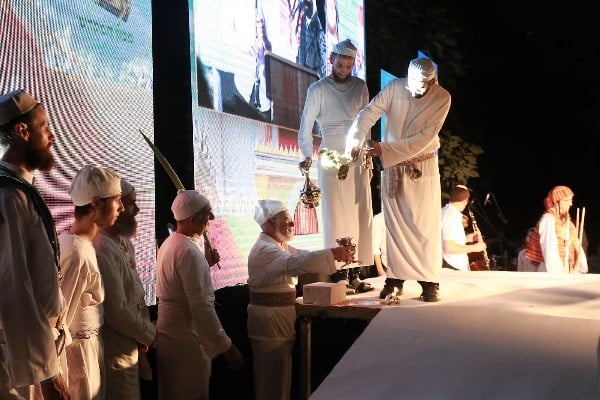Jerusalem’s Chief Ashkenazi, Aryeh Stern blessed the celebrants and noted they were returning the commandments of the Temple to public consciousness.
By Aryeh Savir, TPS
Thousands of Israelis participated on Tuesday evening at the foot of the Temple Mount in a unique recreation of the Sukkot “Nissuch HaMayim” water libation ceremony, drawing water from the Shiloach spring in the City of David.
Participants made a festive procession from the Dung Gate, near the Western Wall, while blowing horns, singing with musical instruments, and carrying the traditional four species of Sukkot.
A priest in special priestly garments drew water from the Shiloach pool in a gold saucer to the sound of singing and the blowing of the trumpets of the attendants, and the prayers of the crowd for the blessing of rain in the coming year.
In a solemn march back to the Temple Mount area, the crowds recreated the ascent up to the Dung Gate. An altar-like structure was erected there, on which the priests poured the water and wine, as was done in the Temple, under the direction of Rabbi Baruch Kahana and under the guidance of Rabbi Mordechai Tzin.
The “Pouring of the Water” was an important feature of the festival of Sukkot during the times of the Temple. The drawing of water ceremony was preceded by all-night celebrations in the Temple courtyard known as the “Simchat Beit HaShoeva.”
Jerusalem’s Chief Ashkenazi, Aryeh Stern blessed the celebrants and noted they were returning the commandments of the Temple to the public consciousness.
Rabbi Stern then held a Hakhel ceremony. In Biblical times, this was an assembly every seven years in which every Jew heard the King of Israel read from the Torah to the entire nation.
After Rabbi Stern, Rabbi Haim Shahar of the Temple Yeshiva, Rabbi Azaria Ariel of the Temple Institute, and Rabbi Yosef Elboim of the Temple Mount Administration continued the reading.
In happy dances, the celebrants then recreated the joy of the Simchat Beit HaShoeva celebrations..
Rabbi Shimshon Elboim, who initiated the event with the Temple Institute, said that “the public presence and increasing interest, expands the heart, and convinces that we are indeed closer to this than ever before.”
Rabbi Yisrael Ariel concluded by saying that “it is exciting to see the multitudes who came to restore the mitzvah of the temple. The people of Israel are waking up and thanks to this we will soon be able to observe the mitzvahs that depend on the temple in their place in our time.”
